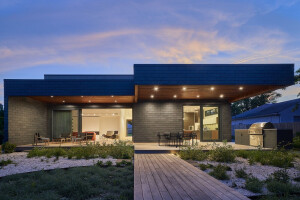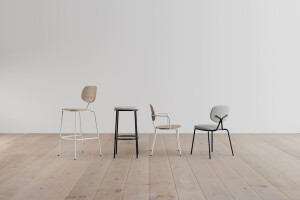This multifunctional apartment building contains a large supermarket, retail space, and 83 social rental homes, of which 13 are quay-side houses. Westerschans 1A is the first phase of the new residential, work and leisure area on the edge of central Goes.
The Westerschans area directly borders the historic city centre, the ring-road, and the water of the Havenkanaal. Westerschans 1A is part of the urban development plan that Jeanne Dekkers Architectuur and ZOETMULDER designed for the entire Westerschans area. This development consists of three building blocks with a varied program of social housing, owner-occupied apartments, commercial spaces, care homes, a supermarket, catering establishments and a hotel.
Articulation of the main form
Westerschans 1A is located on the south side of the Westerschans in Goes and has an consistent architectural identity on all sides. The height of the tower gives identity to the Westerschans, recognisable from a distance. In parallel, the concentrated program ensures that the remainder of the building retains a modest height. The building volume is further divided into different sections, giving the appearance of a reduced scale relative to the whole mass. An opening on the south side frames a view of the city centre.
Life on the quay
On the ground floor a new housing type is introduced: the quay house. These quay houses consist of a half-width plan across two floors. As a result, there are thirteen front doors along the quay, which encourages inhabitation to break out along the car-free quay. The pilasters on the ground floor are finished with either a brick bench or planter. These built-in furnishings mark a semi-private space for the quay houses, stimulating use by the residents.
Brick patterns with a story
The materialization connects the buildings to the public space surrounding them. The most prominent material is derived from the sand-yellow IJsselsteen from the old city centre of Goes. They create a soft contrast with the grey-brown colour of the secondary materials, such as the fencing, window frames, cladding and bricks. The brick patterns on the facade are derived from typical regional stoplap patterns. These embroidered patches have geometric patterns that can be intuitively translated to the proportions of a stretcher bond. Closed facades of the supermarket within the plinth become more lively with the use of these stretcher bond patterns. The cantilevered portion of the building has a large patterned surface that accentuates the long visual axis from the ring-road. On the quay, the pilasters are adorned with simple ascending patterns, similar to the single-stitch edge seen around the stoplap. Using this as an inspiration creates a unique connection between the history and identity of the Westerschans.
Special durability
Westerschans 1A is connected to an ice buffer; a special system for hot and cold storage. This ice buffer consists of a large source vessel of 15 meters diameter filled with ice, in combination with solar air collectors and PV cells on the roof. The building is heated and cooled using crystallization heat.
Material Used :
1. Rodruza - Bricks
2. Trespa - Exterior panels



















































